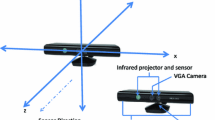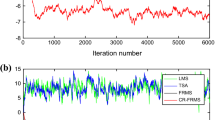Abstract
This paper deals with the Tobit Kalman filtering (TKF) process when the measurements are correlated and censored. The case of interval censoring, i.e., the case of measurements which belong to some interval with given censoring limits, is considered. Two improvements of the standard TKF process are proposed, in order to estimate the hidden state vectors. Firstly, the exact covariance matrix of the censored measurements is calculated by taking into account the censoring limits. Secondly, the probability of a latent (normally distributed) measurement to belong in or out of the uncensored region is calculated by taking into account the Kalman filter residual. The designed algorithm is tested using both synthetic and real data sets. The real data set includes human skeleton joints’ coordinates captured by the Microsoft Kinect II sensor. In order to cope with certain real-life situations that cause problems in human skeleton tracking, such as (self)-occlusions, closely interacting persons, etc., adaptive censoring limits are used in the proposed TKF process. Experiments show that the proposed method outperforms other filtering processes in minimizing the overall root-mean-square error for synthetic and real data sets.






Similar content being viewed by others
References
B. Allik, The tobit Kalman filter: an estimator for censored data. Ph.D. thesis, University of Delaware (2014)
B. Allik, C. Miller, M.J. Piovoso, R. Zurakowski, Estimation of saturated data using the tobit Kalman filter, in 2014 American Control Conference (IEEE) (2014), pp. 4151–4156
B. Allik, C. Miller, M.J. Piovoso, R. Zurakowski, The tobit Kalman filter: An estimator for censored measurements. IEEE Trans. Control Syst. Technol. 24(1), 365–371 (2016)
M.S. Arulampalam, S. Maskell, N. Gordon, T. Clapp, A tutorial on particle filters for online nonlinear/non-gaussian bayesian tracking. IEEE Trans. Signal Process. 50(2), 174–188 (2002)
S. Asteriadis, A. Chatzitofis, D. Zarpalas, D.S. Alexiadis, P. Daras, Estimating human motion from multiple kinect sensors, in Proceedings of the 6th International Conference on Computer Vision/Computer Graphics Collaboration Techniques and Applications (ACM) (2013), p. 3
E.M. Berti, A.J.S. Salmerón, F. Benimeli, Kalman filter for tracking robotic arms using low cost 3d vision systems, in The Fifth International Conference on Advances in Computer–Human Interactions (2012), pp. 236–240
F. Destelle, A. Ahmadi, N.E. O’Connor, K. Moran, A. Chatzitofis, D. Zarpalas, P. Daras, Low-cost accurate skeleton tracking based on fusion of kinect and wearable inertial sensors, in 2014 22nd European Signal Processing Conference (EUSIPCO) (IEEE) (2014), pp. 371–375
J. Deutscher, A. Blake, I. Reid, Articulated body motion capture by annealed particle filtering, in Proceedings of IEEE Conference on Computer Vision and Pattern Recognition, 2000. vol. 2 (IEEE) (2000), pp. 126–133
Y. Du, W. Wang, L. Wang, Hierarchical recurrent neural network for skeleton based action recognition, in Proceedings of the IEEE Conference on Computer Vision and Pattern Recognition (2015), pp. 1110–1118
M. Edwards, R. Green, Low-latency filtering of kinect skeleton data for video game control, in Proceedings of the 29th International Conference on Image and Vision Computing New Zealand (ACM) (2014), pp. 190–195
B. Galna, G. Barry, D. Jackson, D. Mhiripiri, P. Olivier, L. Rochester, Accuracy of the microsoft kinect sensor for measuring movement in people with parkinson’s disease. Gait Posture 39(4), 1062–1068 (2014)
M.S. Grewal, Kalman Filtering (Springer, Berlin, 2011)
F. Gustafsson, G. Hendeby, Some relations between extended and unscented Kalman filters. IEEE Trans. Signal Process. 60(2), 545–555 (2012)
J.D. Hamilton, Time Series Analysis, vol. 2 (Princeton University Press, Princeton, 1994)
J. Hampshire, J.W. Strohbehn, Tobit maximum-likelihood estimation for stochastic time series affected by receiver saturation. IEEE Trans. Inf. Theory 38(2), 457–469 (1992)
F. Han, H. Dong, Z. Wang, G. Li, F.E. Alsaadi, Improved tobit Kalman filtering for systems with random parameters via conditional expectation. Signal Process. 147, 33–45 (2018)
A.C. Harvey, Forecasting, Structural Time Series Models and the Kalman Filter (Cambridge University Press, Cambridge, 1990)
S.J. Julier, The scaled unscented transformation, in Proceedings of the 2002 American Control Conference (IEEE Cat. No. CH37301), vol. 6, (IEEE) (2002), pp. 4555–4559
P.S. Kalekar, Time series forecasting using holt-winters exponential smoothing. Kanwal Rekhi Sch. Inf. Technol. 4329008, 1–13 (2004)
R.E. Kalman, A new approach to linear filtering and prediction problems. J. Basic Eng. 82(1), 35–45 (1960)
A. Kar, Skeletal tracking using microsoft kinect. Methodology 1, 1–11 (2010)
M. Kinect, Skeletal joint smoothing white paper. https://msdn.microsoft.com/en-us/library/jj131429.aspx/. Accessed July 07 2016
B.F. La Scala, R.R. Bitmead, Design of an extended Kalman filter frequency tracker. IEEE Trans. Signal Process. 44(3), 739–742 (1996)
A.B.L. Larsen, S. Hauberg, K.S. Pedersen. Unscented Kalman filtering for articulated human tracking, in Scandinavian Conference on Image Analysis (Springer) (2011), pp. 228–237
X.R. Li, Z. Zhao, Measuring estimator’s credibility: noncredibility index, in 2006 9th International Conference on Information Fusion (IEEE) (2006), pp. 1–8
X.R. Li, Z. Zhao, V.P. Jilkov, Estimator’s credibility and its measures, in Proceedings of the IFAC 15th World Congress (2002)
Z. Li, Z. Wei, Y. Yue, H. Wang, W. Jia, L.E. Burke, T. Baranowski, M. Sun, An adaptive hidden markov model for activity recognition based on a wearable multi-sensor device. J. Med. Syst. 39(5), 1–10 (2015)
T.J. Lim, Y. Ma, The Kalman filter as the optimal linear minimum mean-squared error multiuser cdma detector. IEEE Trans. Inf. Theory 46(7), 2561–2566 (2000)
K. Loumponias, N. Vretos, P. Daras, G. Tsaklidis, Using tobit Kalman filtering in order to improve the motion recorded by microsoft kinect, in Proceedings of the International workshop on applied probability (IWAP), Toronto, Canada (2016)
K. Loumponias, N. Vretos, G. Tsaklidis, P. Daras, Using Kalman filter and tobit Kalman filter in order to improve the motion recorded by kinect sensor ii, in Proceedings of the 29th Panhellenic Statistics Conference, Naousa, Greece (2016), pp. 322–334
B. Manjunath, S. Wilhelm, Moments calculation for the double truncated multivariate normal density (2009)
C. Masreliez, R. Martin, Robust bayesian estimation for the linear model and robustifying the Kalman filter. IEEE Trans. Autom. Control 22(3), 361–371 (1977)
R.G. Miller Jr., Survival Analysis, vol. 66 (Wiley, Hoboken, 2011)
A. Mobini, S. Behzadipour, M. Saadat Foumani, Accuracy of kinect’s skeleton tracking for upper body rehabilitation applications. Disabil Rehabil Assist Technol 9(4), 344–352 (2014)
T.B. Moeslund, A. Hilton, V. Krüger, L. Sigal, Visual Analysis of Humans (Springer, Berlin, 2011)
S. Moon, Y. Park, D.W. Ko, I.H. Suh, Multiple kinect sensor fusion for human skeleton tracking using Kalman filtering. Int. J. Adv. Robot. Syst. 13, 65 (2016)
P. Moore, The estimation of the mean of a censored normal distribution by ordered variables. Biometrika 43(3/4), 482–485 (1956)
A. Savitzky, M.J. Golay, Smoothing and differentiation of data by simplified least squares procedures. Anal. Chem. 36(8), 1627–1639 (1964)
J. Tobin, Estimation of relationships for limited dependent variables. Econom. J. Econom. Soc. 26(1), 24–36 (1958)
B.W. Turnbull, The empirical distribution function with arbitrarily grouped, censored and truncated data. J. R. Stat. Soc. Ser. B (Methodol.) 38, 290–295 (1976)
J. Wang, Z. Liu, Y. Wu, J. Yuan, Learning actionlet ensemble for 3d human action recognition. IEEE Trans. Pattern Anal. Mach. Intell. 36(5), 914–927 (2014)
W.W.-S. Wei, Time Series Analysis (Addison-Wesley publ Reading, Boston, 1994)
G. Whitmore, F. Schenkelberg, Modelling accelerated degradation data using wiener diffusion with a time scale transformation. Lifetime Data Anal. 3(1), 27–45 (1997)
X. Yang, Y. Tian, Super normal vector for human activity recognition with depth cameras. IEEE Trans. Pattern Anal. Mach. Intell. PP(99), 1–1 (2016)
C. Zhang, L. Zhang, Activity recognition in smart homes based on second-order hidden markov model. Int. J. Smart Home 7(6), 237–244 (2013)
Acknowledgements
This work was supported by the European Project (Horizon2020) ICT4Life under GA 690090.
Author information
Authors and Affiliations
Corresponding author
Additional information
Publisher's Note
Springer Nature remains neutral with regard to jurisdictional claims in published maps and institutional affiliations.
Appendices
Appendix A: The Censored Mean Value
In what follows, the proof of Proposition 2 is provided:
Proof of Proposition 2, Sect. 3.3
For a discrete random variable \( z_i \sim B(p_i) \) (Bernoulli distribution) in Lemma 1, it is derived that
The censored measurement, \( y_i \), can be written in terms of Bernoulli distributions; therefore, the censored mean value is written by (42) as,
where the first term is the sum of all possible mean values of \( {{\,\mathrm{\mathbb {E}}\,}}(y_i|a_i<y_i<b_i)\) given that the rest variables lie in a region \( R_j = [(L_1,U_1),\ldots ,(L_{i-1},U_{i-1}),(L_{i+1},U_{i+1}),\ldots ,(L_n,U_n)] \), where
where j=1,...,\( 3^{n-1} \). \(P((a_i,b_i),R_j) \) denotes the probability of variable \( \mathbf{y }^* \) to lie in a region \([(a_i,b_i),R_j]. \) It is derived by (5) that
where \( \big (F_{k}(L_k)-F_{k}(U_k)\big )_{R_j} \) is the difference of functions (6) given that the variable \( \mathbf{y }^* \) lies in the region \( R_j \cup (a_i,b_i) \). In the case where \( k \ne i \), it is derived that:
where \(V_j \) is the region
In the case where \( k = i \), it is derived that,
where \( f_i(y^*_i) \) is the normal distribution of \( y^*_i \sim N(\mu _i, \sigma _{i,i}) \). Thus, by (44)-(46) arises
\(\square \)
Appendix B: The Censored Covariance Matrix
In what follows, the proof of Proposition 3 is provided:
Proof of Proposition 3, Sect. 3.3
In the same way as for the censored mean (“Appendix A”), it is proved that the second moment of \( y_i \) depends on the censoring limits {\( a_i \), \( b_i \)}. Therefore, it is derived by Lemma 1 that
where the first term [31] is equal with
Therefore, it is derived by (48) that,
Finally, the censored variance is given by
where \( P_{un}^i = P(a_i<y^*_i<b_i) \), \( P_{a}^i= P(y^*_i \le a_i)\) and \( P_{b}^i = P(y^*_i \ge b_i) \).
The expectation value of \( y_i \cdot y_j \) is written by Lemma 1 as:
where
and \( G_k \) for \( k=1,\ldots ,3^{n-2} \) denote a region (as in the case of the censored mean) where the multi-variable, \( \mathbf{y }^*_{-i-j} \), lies on.
Concerning the last five terms of (51), it is proved (as in case of second moment) that they depend only on the censoring limits {\( a_i \), \( b_i \), \( a_j \), \( b_j \)}; thus, (51) can be written as
where
At this point, it should be noted that the truncated moments \( {{\,\mathrm{\mathbb {E}}\,}}(y^*_{i}|\cdot ) \) and \( {{\,\mathrm{\mathbb {E}}\,}}(y^*_{i}y^*_{j}|\cdot ) \) in (52) are calculated by (5) and (5), respectively. Although the functions (6), (7) in our case (censoring measurements) are defined only for the variables \( y^*_i \) and \(y^*_j \), i.e.,:
and
Therefore, the covariance matrix can be defined by the terms (47), (50) and (52). \(\square \)
Appendix C: Evaluation of the Probabilities of the Latent Measurement to Belong to the Censored or Uncensored Region
In what follows, the proofs for (13)–(15) are provided.
The mean of the latent measurement \( \mathbf{y }^*_{k} \) given the saturated measurement \(\mathbf{y }_{k-1} \) is
The covariance matrix of \( \mathbf{y }^*_{k}-\mathbf{H }_k\hat{\mathbf{x }}^-_{k} \) is
thus,
By (53) and (54), it is clear that \(\mathbf{y }^*_{k}|\mathbf{y }_{k-1}\sim ~N(\mathbf{m }_k, \mathbf{S }_k)\). The probability \( P^i_{\mathbf{a },k} \) of the \( i{\mathrm{th}} \) component of the latent measurement \( \mathbf{y }^*_k \) to be equal or less than \( a_i \) is
Following the same procedure, the probability \( P^i_{\mathbf{b },k} \) of the \( i{\mathrm{th}} \) component of the latent measurement \( \mathbf{y }^*_k \) to be equal or bigger than \( b_i \) is
Finally, the probability of the \( i{\mathrm{th}} \) component of the latent measurement \( \mathbf{y }^*_k \) to lie in the uncensored region \( (a_i, b_i) \) is
\(\square \)
Rights and permissions
About this article
Cite this article
Loumponias, K., Vretos, N., Tsaklidis, G. et al. An Improved Tobit Kalman Filter with Adaptive Censoring Limits. Circuits Syst Signal Process 39, 5588–5617 (2020). https://doi.org/10.1007/s00034-020-01422-w
Received:
Revised:
Accepted:
Published:
Issue Date:
DOI: https://doi.org/10.1007/s00034-020-01422-w




